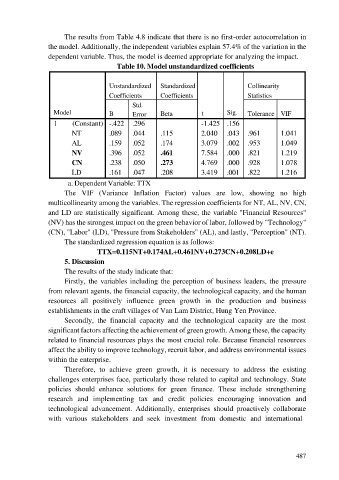Page 495 - Ebook HTKH 2024
P. 495
The results from Table 4.8 indicate that there is no first-order autocorrelation in
the model. Additionally, the independent variables explain 57.4% of the variation in the
dependent variable. Thus, the model is deemed appropriate for analyzing the impact.
Table 10. Model unstandardized coefficients
Unstandardized Standardized Collinearity
Coefficients Coefficients Statistics
Std.
Model B Error Beta t Sig. Tolerance VIF
1 (Constant) -.422 .296 -1.425 .156
NT .089 .044 .115 2.040 .043 .961 1.041
AL .159 .052 .174 3.079 .002 .953 1.049
NV .396 .052 .461 7.584 .000 .821 1.219
CN .238 .050 .273 4.769 .000 .928 1.078
LD .161 .047 .208 3.419 .001 .822 1.216
a. Dependent Variable: TTX
The VIF (Variance Inflation Factor) values are low, showing no high
multicollinearity among the variables. The regression coefficients for NT, AL, NV, CN,
and LD are statistically significant. Among these, the variable "Financial Resources"
(NV) has the strongest impact on the green behavior of labor, followed by "Technology"
(CN), "Labor" (LD), "Pressure from Stakeholders" (AL), and lastly, "Perception" (NT).
The standardized regression equation is as follows:
TTX=0.115NT+0.174AL+0.461NV+0.273CN+0.208LD+e
5. Discussion
The results of the study indicate that:
Firstly, the variables including the perception of business leaders, the pressure
from relevant agents, the financial capacity, the technological capacity, and the human
resources all positively influence green growth in the production and business
establishments in the craft villages of Van Lam District, Hung Yen Province.
Secondly, the financial capacity and the technological capacity are the most
significant factors affecting the achievement of green growth. Among these, the capacity
related to financial resources plays the most crucial role. Because financial resources
affect the ability to improve technology, recruit labor, and address environmental issues
within the enterprise.
Therefore, to achieve green growth, it is necessary to address the existing
challenges enterprises face, particularly those related to capital and technology. State
policies should enhance solutions for green finance. These include strengthening
research and implementing tax and credit policies encouraging innovation and
technological advancement. Additionally, enterprises should proactively collaborate
with various stakeholders and seek investment from domestic and international
487

